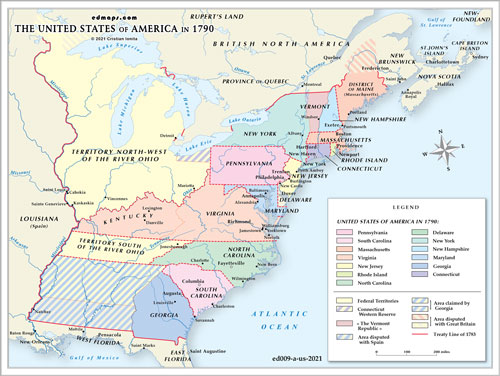The United States of America in 1790


The United States of America in 1790
In 1790, the United States was still in its early years as a nation, and its western frontiers were still expanding. At that time, the country's territory extended to the Mississippi River, marking its western boundary. Let's explore some of the frontiers and significant developments during that period:
The Northwest Territory: The United States had gained control of the Northwest Territory through the Treaty of Paris in 1783, which ended the American Revolutionary War. The region encompassed present-day Ohio, Indiana, Illinois, Michigan, Wisconsin, and part of Minnesota. Settlements were being established, and Ohio became the first state from this territory in 1803.
The Appalachian Mountains: The Appalachian Mountains served as a natural barrier and formed the western frontier for many early American settlers. However, pioneers were gradually pushing westward into the mountainous regions, establishing communities and opening up new territories for settlement.
Spanish territories: Spain controlled several territories adjacent to the United States. Florida, both East and West Florida, was under Spanish control until it was acquired by the United States in 1819 through the Adams-Onís Treaty. Spanish Texas also bordered the United States to the west and southwest.
Native American lands: Native American tribes occupied vast areas of land across the continent. As American settlers moved westward, conflicts arose between Native tribes and the expanding United States. The Northwest Indian War (1785-1795) took place during this period, which resulted in the defeat of several Native tribes in the Ohio River Valley region.
Exploration and territorial expansion: During this time, the United States saw various explorations and expeditions aimed at surveying and documenting the western territories. For example, the 1792 expedition led by Captain George Vancouver explored the Pacific Northwest region, while Spanish explorers like Juan Bautista de Anza made efforts to expand Spanish influence in California.
It's important to note that the concept of the American frontier was constantly evolving during this period, with new lands being explored and settled. The United States would continue to expand its borders through various means, including diplomatic negotiations, purchases (like the Louisiana Purchase in 1803), and sometimes through conflicts and wars, as it pursued its vision of westward expansion and manifest destiny.








